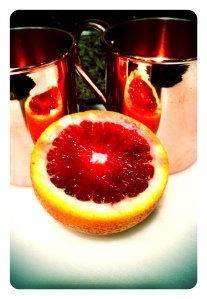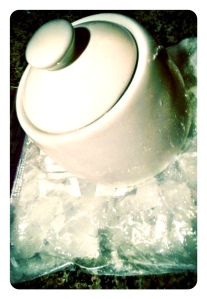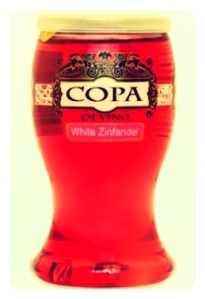Category: Branding and Marketing
A Brief Interlude for Cocktails – In a Parking Lot
Caitlin – January 21st, 2013
Yesterday we had a weird lunch at Heavy Seas Alehouse. I ordered a Musket Ball. According to the menu, a Musket Ball is a cocktail made of Bulleit bourbon (regular), Bulleit bourbon (rye), a syrup derived from Heavy Seas Gold Ale, and black walnut bitters. My conversation with the bartender went something like this:
Me: I’d like a Musket Ball please.
Bartender: I have no idea what that is.
Me: It’s right here on the menu, see? Bourbon, syrup, and bitters.
Bartender: I’ll make it, but I don’t think you’re going to like it. <pause>
Bartender: I don’t agree with anything that’s on this entire menu.
In my head I said, “you’re not allowed to say that!” but outwardly I panicked. I think I just ended up staring at him silently. He made me the drink. He was right. I didn’t like it. It was good in concept, but as you can probably infer, he didn’t try very hard to make it. It showed.
He then insisted on making me a gin martini (off-menu). I wanted to hate it.
It was amazing. Which irritated me even more. So there.
Anyway, while we were drinking and eating, and because it was game-day, Robert and I got to talking about what makes a good tailgating cocktail. Since you’re making it in a parking lot, you need easy ingredients. It needs to be easy to make and easy to clean-up. We came up with some rules:
- You should be able to measure it pretty accurately without the use of a jigger or shot glass.
- You shouldn’t have to mix it in a cocktail shaker.
- You shouldn’t need a cutting board or knives.
- It should have enough ingredients to be interesting but not too many.
- You should be able to drink it during any time of day.
- You should be able to easily make riffs on it, to appeal to almost any tailgating party attendee.
Well, that’s what makes a good tailgating cocktail. But what makes a really memorable tailgating cocktail? Something painless for you, as the host, but new and different for your guests. The glassware, of course! In this case, the copperware. Copper mugs.
Let’s begin with a brief history of the copper mug. Copper has been used as a drinking vessel for thousands of years. In ancient Ireland, people drank from a copper (and/or silver) goblet called an escra. American colonists drank from copper mugs. And, in the 1940s, the Moscow Mule was invented out of necessity by one Mr. John Martin.
John Martin was the president of G.F. Heublein & Brothers, an East Coast food and spirits importer. He purchased a small vodka distillery called Smirnoff (perhaps you’ve heard of it?) for $14,000. Vodka was not popular at the time, and he was hoping to find himself at the forefront of the next major cocktail craze.
As the story goes, John Martin was visiting his friend Jack Morgan, owner of the Cock ‘n Bull pub in Hollywood. John Martin bemoaned the fact that he couldn’t sell his vodka. Jack Morgan complained he couldn’t sell his ginger beer. A third mystery person lamented that she had copper mugs that she either didn’t want or need. The vodka and ginger beer were mixed with a dash of lime juice and served in the unwanted copper mugs. And thanks to arguably the most successful marketing campaign in cocktail history, the Moscow Mule became one of the most popular drinks of the 1950s and 60s.
Robert asked for, and received, copper mugs for Christmas this year. It didn’t occur to me at the time, but it did during lunch: copper mugs are the perfect tailgating drinking vessel. They are remarkable, noteworthy, and memorable. They are light. You can drop them on the ground and they won’t break. They stay very, very cold for an extended period of time. A copper mug is the perfect way to elevate a relatively simple cocktail. Not to mention, you can win friends and influence people by regaling them with the famous tale of Martin, Morgan, and their mystery date. Hours of fun. Hours, I tell you!
Now, what to put in it this wonderful mug? Heeding rules #1 through #5, I came up with the following concoction. The Parking Lot. You need:
Bourbon (in homage to the Musket Ball that wasn’t, I used Bulleit)
Fresh blood oranges
Chipped ice
Champagne
Simple syrup
Easy: Make the simple syrup the evening before, allow it to cool, and pour it into a squeeze bottle. Juice your blood oranges and store in a separate squeeze bottle, or simply cut the oranges in half and wrap in Saran™ Wrap so they don’t dry out. Make chipped ice by crushing ice cubes in a Ziploc® bag using a rolling-pin. If you don’t have a rolling-pin, because you live in a corporate apartment like me, use whatever you have on hand. I used our sugar bowl. Store the chipped ice in the freezer until it’s ready to be transferred to your cooler.
Even easier: Mix the juice and the simple syrup to taste beforehand and you’ll only need to bring one squeeze bottle.
Fill a standard, 13.5oz copper mug with chipped ice, then fill approximately 1/4 of the mug with bourbon. Squeeze in the juice of one blood orange and add simple syrup to taste (I used approximately one tablespoon). The mug should now be approximately 3/4 of the way full. Slosh around to mix. Top with champagne.
So, does it meet the criteria? I think so.
- You should be able to measure it pretty accurately without the use of a jigger or shot glass. You can easily eyeball the bourbon and the fresh fruit juice and champagne forgive most errors.
- You shouldn’t have to mix it in a cocktail shaker. Simple syrup easily dissolves in liquor, no shaking required. Just a little sloshing.
- You shouldn’t need a cutting board or knives. Cutting the fruit the night beforehand or morning of eliminates the need for a cutting board or knives.
- It should have enough ingredients to be interesting but not too many. In the wintertime, blood oranges are as easy to find as oranges, but have the benefit of being way more interesting.
- You should be able to drink it during any time of day. Since this is topped with champagne, it’s perfectly appropriate for the morning. Since it also has bourbon, it is grown-up enough for the afternoon and evening.
- You should be able to easily make riffs on it to appeal to almost any tailgating party attendee. Someone doesn’t like bourbon? Serve them champagne and blood orange juice in a GoVino stemless plastic champagne flute. Someone doesn’t drink? Fresh squeezed juice it is! Someone doesn’t like champagne? Don’t top their cocktail off and you’re basically serving them an Old-Fashioned.
We are 99.9 percent sure that this cocktail played a leading role in the Ravens victory over the Patriots, so we will be making a big batch of them for the Super Bowl. Boom. What are some of your game-day favorites? Leave a reply in the comments section below!
I Have Some Concerns
Caitlin – January 18th, 2013
A few weeks ago, I told you to drink whatever you want. It’s no one’s business but yours. I still think that’s true. You should drink white wine. You should even drink Two-Buck Chuck. It goes without saying, but I also think you should treat yourself to a few bottles as a long-term investment, and drink those too. Why should you drink cheap wine, you ask? For the same reason you should drink expensive wine. Experimenting with a broad selection of vintages and varietals, from a large number of regions at varying price points, will help expand your palate and hone your wine drinking persona.
As I was drafting this post, Robert and I exchanged the following dialogue via text message:
Me: What’s the worst wine we ever drank (non-corked)?
Robert: Probably something from Virginia.* <long pause>
Robert: NO!
Robert: That Merlot from Woodrose.
Me: THE ONE THAT TASTED LIKE FEET?
Robert: Yes.
It did taste like feet, you guys. For real. Only with a high level of skepticism would I drink anything from Woodrose Winery again. I would, though. Most winemakers change, grow, and improve. We’re pulling for them. Some winemakers, on the other hand, are consistently reliable. For example, I will always buy Phantom. Wide-ranging trial-and-error helped me draw these conclusions.
Some wine is cheap because it’s mass produced. Some wine is cheap because it’s terrible. But the price of a wine neither indicates nor guarantees quality. A cheap wine can taste great and an expensive wine can taste like feet. You need two skills to ensure you always get a good value:
- You need to know what you like.
- You need to be able to describe it to a wine merchant, winemaker, or sommelier.
Wine can be terrible because it just doesn’t taste good. Maybe the winemaker is not good at their job. Or maybe they don’t care about the product, they only care about profit. Some winemakers who say they make wine aren’t really making wine at all. I’m talking to you, Arbor Mist, you assholes. This is the first category of bad wine.
Wine can also terrible because of a specific fault, the most well-known of which is cork taint. A wine is corked when a compound (specifically, 2,4,6-trichloroanisole, known as TCA, and/or 2,4,6-tribromoanisole, known as TBA) is transferred from or through the cork. Corked wine containing TCA and/or TBA has a characteristic odor: moldy, filthy, and damp. Other faults, like oxidation, can be harder to identify, but we can cover the general topic of potential faults after bottling in a future post. This is the second category of bad wine.
There is a third category. Unfortunately for you, me, and the future of humanity, there is a third category. Wine can be terrible because the entire concept is so deeply flawed and antithetical to the entire point of wine drinking that I want to put myself into a medicated coma over it. That’s a gross exaggeration. But I am concerned. I am really, really concerned about Copa Di Vino.
Copa Di Vino is a sealed plastic drinking cup that looks like glass and contains good-quality Washington State wine. Each Copa Di Vino contains the equivalent of a quarter of a bottle of wine and is designed for younger wine drinkers who want grab-and-go convenience and don’t want to drink a whole bottle at a time. Good Fruit Grower
Single-serving wine isn’t a new concept. In fact, the maker of Copa di Vino got the idea when he was on a train with his wife during a vacation in France in 2008. The company that produces the single-serving wine in France, ¼ Vin, agreed to partner with Copa di Vino to patent the bottling and sealing technology in the United States. As I’ve mentioned in the past, I’m a big fan of wine technology. I think cork alternatives (i.e., screw tops) are a great idea. I will definitely have a vineyard robot. I have to draw the line at single-serving wine. My issues? I have two. First of all, wine is not a soft drink, nor is it beer. Grab-and-go convenience isn’t a phrase you should be using to describe what you’re looking for in a wine. Second of all, wine is a living thing. It should never be vacuum-sealed. These are the commandments of this blog. They’ve both been broken.
There is also this: real-life quotes in support of Copa di Vino. I am not making any of these up:
It combines the classiness of a bottle of fine wine with the convenience of a drink pouch.
I may be a wine snob, but I’m a wine snob on the go.
Mr. Franzia will always live on in our hearts for one of the most wonderful inventions of all time, but it may be time for us to move on…each sealed disposable wine glass comes filled with six ounces of red, white or rosé that look good enough to drink at a fancy dinner party.
No. Just…no. Just stop it. No they don’t look good enough to drink at a fancy dinner party. Someone help me. Is anything sacred? Drink whatever you want. Just not Copa di Vino.
*We’ve had some very good wines from Virginia. Barboursville and Valhalla come to mind.
A Note About Labels and Branding – We Disagree…Still Seeking a Name for our White Wine
Caitlin – November 30th, 2012
A month or two ago (pre-fire – which will come into play later in this post), Robert and I had the following conversation:
Me: Guess what? I named our white wine!
Robert: Really? What did you name it?
Me: Bald-Faced Hornet
Robert: What?
Me: It’s a type of bee with a white face! Get it? White wine…white bee…goes with Abeille?
Robert: I like your enthusiasm but we’re not naming our wine Bald-Faced Hornet. It doesn’t make any sense.
Me: Neither does Google, or Amazon! It’s edgy! It’s cool!
Robert: No, it’s just not an appetizing name.
Me: But I already mocked-up a label. Please?
Robert: Just…just no.
One topic we haven’t covered yet is the importance of wine branding and marketing. Wine is a multi-billion dollar global industry. Like most industries, while focusing on your product is very important, so is understanding buying decisions and the factors that influence them, product differentiation, and fostering brand loyalty. We don’t sell our wine right now, but if we ever plan to sell it, we need to start building a brand now. And we need your help! You know us. We just can’t stop Tom Sawyering.
Specifically, on the topic of labels, what should a label convey? It should give the consumer an indication of what’s in the bottle, and ideally, what the benefits of purchasing and drinking the wine are. Research has shown that the more complex the label, the more value the consumer perceives, and the more they are willing to spend. Wine labels are also, uniquely, more than a marketing tool: they’re art.
There is a gulf in the international wine marketplace between old world (French) and new world (American, Australian, New Zealand, etc.) wine regulations as they relate to labeling. The appellation d’origine contrôlée (AOC) “controlled designation of origin”, is the French certification granted to certain French geological areas for wine (as well as cheese and butter). The first law on viticultural designations dates back to 1905.
These regulations are intended to guarantee that all AOC products adhere to defined standards. AOC products must be produced in a traditional manner with ingredients from specific producers within their designated geographical area, and aged at least partially in the designated area. An AOC you might be familiar with is the Côtes du Rhône. Why am I telling you all of this? Well, French legislation concerning the way vineyards are identified makes recognizing the various AOCs very challenging for wine drinkers unfamiliar with the system. Often, distinguishing classifications requires knowledge of bizarre label laws:
Unless the wine is from a Premier Cru vineyard, the vineyard name must be printed in characters no more than half the height of the ones used for the village name.
You need to understand font regulations to interpret a French wine label. You’re right, though. To be fair, bizarre is my editorial opinion. What I am trying to say is, French regulations place more emphasis on the region where the wine was produced than on the varietal, and French labels are restricted by law. This makes it difficult for the average consumer to understand what they are buying. A wine marked Côtes du Rhône could be a Grenache, Syrah, Cinsault, Carignane, Counoise, or Mourvèdre (if red), or a Clairette, Grenache Blanc, Marsanne, Roussanne, Bourboulenc, or Viognier (if white). Are you confused yet? I told you. New world labels, on the other hand, emphasize the brand or producer and the grape variety or blend. Simple.



What are the implications for naming and labeling our white wine? We have a lot of flexibility. Now, if we could only agree. We think it’s obvious that we need to come up with something fire-related, particularly since there is an outside chance this year’s vintage is going to have a “unique” smoky quality. We haven’t been able to come up with something snazzy. Pheonix…too obvious. Prometheus…too obvious. Put your thinking caps on, people. Now accepting suggestions.







